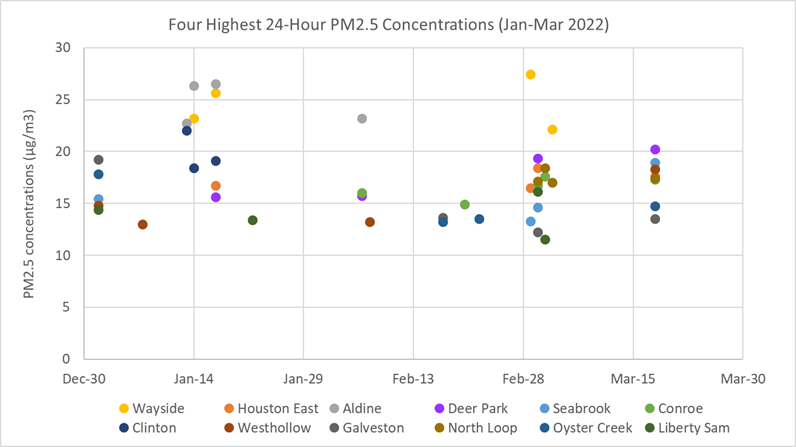Big Gaps in Air Monitoring
Air quality in the U.S. has improved tremendously over the last 50 years thanks to the Clean Air Act Amendments of 1970, but not all neighborhoods have benefited from these improvements. The law mandated the Environmental Protection Agency (EPA) to establish National Ambient Air Quality Standards (NAAQS) and to determine which areas of the country meet the standards and which do not, setting the foundation for air quality management in the U.S.
Air quality management agencies and EPA rely on data from regulatory monitoring networks that exist across the country. However, these monitoring networks are designed to give region-wide pollution averages, and monitors are often sparsely located. For the 25 largest U.S. urban areas with continuous regulatory monitoring, there are an average of only 2 to 5 monitors per million people. Some of these monitors are intentionally sited away from emissions sources to capture background pollution levels; the trade-off is that they can miss critical pollution hotspots, especially near major sources of pollution.
This is exactly what happens in Houston, TX. High levels of harmful particulate matter (PM2.5) have for far too long gone undetected. One such area is the Settegast neighborhood, northeast of downtown Houston, where community members have long voiced concern about air pollution from a nearby railyard, concrete batch plants and metal recyclers. Finally, in 2019, the Texas Commission on Environmental Quality (TCEQ) recommended adding a PM2.5 continuous monitor to the Settegast neighborhood at a site on North Wayside Drive to “improve population exposure coverage,” which EPA approved in the same year. At last, the monitor was deployed in May 2021.

Risk of Nonattainment in Houston
Since the deployment, the new monitor has consistently shown some of the highest PM2.5 levels in the Houston-Galveston-Brazoria (HGB) region. The average PM2.5 concentration over the past 11 months exceeds the current annual NAAQS threshold of 12µg/m3, threatening to push the region into nonattainment status for this pollutant. (Table below shows mean concentration = 12.3µg/m3 from May 3, 2021 to March 10, 2022)

The review process currently underway at EPA to reexamine the NAAQS for particulate matter is expected to result in stronger, more health-protective thresholds. It is expected that EPA will make the final ruling on PM NAAQS in Spring 2023, which will trigger a designation process for many areas of the country. A more health-protective standard will make it more difficult for the HGB region to remain in attainment unless actions are taken now to reduce emissions.
A nonattainment designation is costly for a region, both in terms of direct costs of pollution controls and the potential larger economic losses from lower business activities and lost investment opportunities. One analysis estimates that exposure to particle pollution in the nine-county metropolitan Houston area contributed to more than 5,000 premature deaths in 2015 and nearly $50 billion in economic damages.
In addition to the annual trend, the Wayside monitor also shows high short-term spikes in PM2.5 concentrations. So far in 2022, the four peak days of PM2.5 concentrations at this monitor are some of the highest in the HGB region, with peak 24-hour concentrations ranging from 22 to 27µg/m3. (See diagram below. Wayside measurements are shown in yellow dots.)

Where Is Pollution Coming From?
The Wayside monitor sits ~700ft east of the Union Pacific railyard. Traditionally, railyards and the associated locomotives and drayage truck activity are a major source of particulate matter. Other emission sources adjacent to the site include a metal recycler, a concrete batch plant and several nearby truck yards. Flanked between the railyard and North Wayside Drive is a community that includes a large apartment village, a retirement home, a high school and churches. This railyard is also known to have used creosote to preserve wooden ties, which created an underground contaminated plume that has drifted beneath people’s homes.
EDF and partners are developing a tool that would allow us to investigate the sources of emissions that are measured by regulatory monitors like the one on North Wayside. Early data shows high pollution readings that can be traced to multiple industrial locations in that area. Data also shows that on three of the four highest readings in 2022, the source area is to the west of the monitor around the UP railyard.
What Should We Do?
It behooves the region to come together now to address this issue before a nonattainment designation is made. EDF and others are reaching out to TCEQ, the Houston-Galveston Area Council, industry groups and community organizations to identify best-management practices that could be deployed to help reduce the elevated PM2.5 emissions.
At the request of EDF and community groups, TCEQ now plans to install a speciation monitor at Wayside to better evaluate the sources on an ongoing basis. While a more thorough analysis is needed to reach any conclusions about potential sources, there are near-term actions that can be taken to protect communities’ health and to prevent Houston from exceeding the NAAQS threshold.
- TCEQ should be requiring the railyard, local metal recycling and concrete plants to adopt best management practices. For instance, requiring anti-idling devices be installed on locomotives and upgrading to cleaner engines could significantly reduce emissions at the Union Pacific railyard.
- Increasing anti-idling enforcement on main truck routes and around truck-attracting facilities can also lower truck emissions in the near-term.
- TCEQ could also require industrial facilities such as metal recyclers to adopt best practices to minimize both primary and fugitive emissions, including adoption of abatement and control equipment.
- There is a need and opportunity for broad adoption of zero-emission equipment which is readily available and affordable, as costs have come down significantly in the last few years.
EDF will continue to facilitate discussions among stakeholders on this issue and support efforts to minimize pollution and help position Houston to meet the current–and future–national air standard to protect people’s health.
